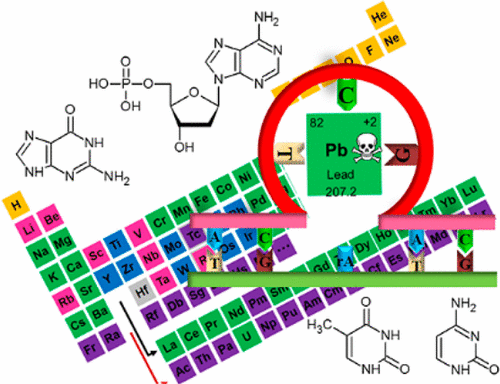当前位置:
X-MOL 学术
›
Chem. Rev.
›
论文详情
Our official English website, www.x-mol.net, welcomes your
feedback! (Note: you will need to create a separate account there.)
Metal Sensing by DNA
Chemical Reviews ( IF 51.4 ) Pub Date : 2017-06-09 00:00:00 , DOI: 10.1021/acs.chemrev.7b00063 Wenhu Zhou 1, 2 , Runjhun Saran 2 , Juewen Liu 2
Chemical Reviews ( IF 51.4 ) Pub Date : 2017-06-09 00:00:00 , DOI: 10.1021/acs.chemrev.7b00063 Wenhu Zhou 1, 2 , Runjhun Saran 2 , Juewen Liu 2
Affiliation

|
Metal ions are essential to many chemical, biological, and environmental processes. In the past two decades, many DNA-based metal sensors have emerged. While the main biological role of DNA is to store genetic information, its chemical structure is ideal for metal binding via both the phosphate backbone and nucleobases. DNA is highly stable, cost-effective, easy to modify, and amenable to combinatorial selection. Two main classes of functional DNA were developed for metal sensing: aptamers and DNAzymes. While a few metal binding aptamers are known, it is generally quite difficult to isolate such aptamers. On the other hand, DNAzymes are powerful tools for metal sensing since they are selected based on catalytic activity, thus bypassing the need for metal immobilization. In the last five years, a new surge of development has been made on isolating new metal-sensing DNA sequences. To date, many important metals can be selectively detected by DNA often down to the low parts-per-billion level. Herein, each metal ion and the known DNA sequences for its sensing are reviewed. We focus on the fundamental aspect of metal binding, emphasizing the distinct chemical property of each metal. Instead of reviewing each published sensor, a high-level summary of signaling methods is made as a separate section. In principle, each signaling strategy can be applied to many DNA sequences for designing sensors. Finally, a few specific applications are highlighted, and future research opportunities are discussed.
中文翻译:

DNA的金属感测
金属离子对于许多化学,生物和环境过程至关重要。在过去的二十年中,出现了许多基于DNA的金属传感器。尽管DNA的主要生物学作用是存储遗传信息,但其化学结构非常适合通过磷酸盐骨架和核碱基进行金属结合。DNA高度稳定,具有成本效益,易于修饰且适合组合选择。已开发出用于金属感测的两大类功能性DNA:适体和DNA酶。尽管已知一些金属结合适体,但通常很难分离出这类适体。另一方面,DNA酶是用于金属感测的强大工具,因为它们是基于催化活性进行选择的,因此无需进行金属固定。在过去的五年中,在分离新的金属感测DNA序列方面已经有了新的发展。迄今为止,DNA可以选择性地检测出许多重要的金属,通常低至十亿分之几的水平。在此,对每种金属离子和用于其感测的已知DNA序列进行了综述。我们专注于金属结合的基本方面,强调每种金属的独特化学性质。代替查看每个已发布的传感器,将信令方法的高级摘要作为一个单独的部分进行介绍。原则上,每种信号转导策略都可以应用于许多DNA序列以设计传感器。最后,重点介绍了一些特定的应用程序,并讨论了未来的研究机会。在此,对每种金属离子和用于其感测的已知DNA序列进行了综述。我们专注于金属结合的基本方面,强调每种金属的独特化学性质。代替查看每个已发布的传感器,将信令方法的高级摘要作为一个单独的部分进行介绍。原则上,每种信号转导策略都可以应用于许多DNA序列以设计传感器。最后,重点介绍了一些特定的应用程序,并讨论了未来的研究机会。在此,对每种金属离子和用于其感测的已知DNA序列进行了综述。我们专注于金属结合的基本方面,强调每种金属的独特化学性质。代替查看每个已发布的传感器,将信令方法的高级摘要作为一个单独的部分进行介绍。原则上,每种信号转导策略都可以应用于许多DNA序列以设计传感器。最后,重点介绍了一些特定的应用程序,并讨论了未来的研究机会。每种信号转导策略都可以应用于许多DNA序列以设计传感器。最后,重点介绍了一些特定的应用程序,并讨论了未来的研究机会。每种信号转导策略都可以应用于许多DNA序列以设计传感器。最后,重点介绍了一些特定的应用程序,并讨论了未来的研究机会。
更新日期:2017-06-09
中文翻译:

DNA的金属感测
金属离子对于许多化学,生物和环境过程至关重要。在过去的二十年中,出现了许多基于DNA的金属传感器。尽管DNA的主要生物学作用是存储遗传信息,但其化学结构非常适合通过磷酸盐骨架和核碱基进行金属结合。DNA高度稳定,具有成本效益,易于修饰且适合组合选择。已开发出用于金属感测的两大类功能性DNA:适体和DNA酶。尽管已知一些金属结合适体,但通常很难分离出这类适体。另一方面,DNA酶是用于金属感测的强大工具,因为它们是基于催化活性进行选择的,因此无需进行金属固定。在过去的五年中,在分离新的金属感测DNA序列方面已经有了新的发展。迄今为止,DNA可以选择性地检测出许多重要的金属,通常低至十亿分之几的水平。在此,对每种金属离子和用于其感测的已知DNA序列进行了综述。我们专注于金属结合的基本方面,强调每种金属的独特化学性质。代替查看每个已发布的传感器,将信令方法的高级摘要作为一个单独的部分进行介绍。原则上,每种信号转导策略都可以应用于许多DNA序列以设计传感器。最后,重点介绍了一些特定的应用程序,并讨论了未来的研究机会。在此,对每种金属离子和用于其感测的已知DNA序列进行了综述。我们专注于金属结合的基本方面,强调每种金属的独特化学性质。代替查看每个已发布的传感器,将信令方法的高级摘要作为一个单独的部分进行介绍。原则上,每种信号转导策略都可以应用于许多DNA序列以设计传感器。最后,重点介绍了一些特定的应用程序,并讨论了未来的研究机会。在此,对每种金属离子和用于其感测的已知DNA序列进行了综述。我们专注于金属结合的基本方面,强调每种金属的独特化学性质。代替查看每个已发布的传感器,将信令方法的高级摘要作为一个单独的部分进行介绍。原则上,每种信号转导策略都可以应用于许多DNA序列以设计传感器。最后,重点介绍了一些特定的应用程序,并讨论了未来的研究机会。每种信号转导策略都可以应用于许多DNA序列以设计传感器。最后,重点介绍了一些特定的应用程序,并讨论了未来的研究机会。每种信号转导策略都可以应用于许多DNA序列以设计传感器。最后,重点介绍了一些特定的应用程序,并讨论了未来的研究机会。











































 京公网安备 11010802027423号
京公网安备 11010802027423号